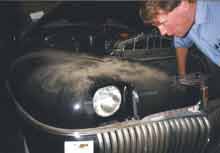Here's Looking at You
This man looks like he's staring down his automobile. Which one do you think will blink first? Actually, he's working on the Airfoil headlights on his 1942 DeSoto.
Before World War II, DeSoto was very much Chrysler Corporation's "idea car." Innovative features were tried out on DeSoto, things like the handsome Miller-inspired grilles of the 1932 and 1933 models - though few of them ever made it into the Mopar mainstream. For 1942, DeSoto pulled out all the stops.
Most obvious from the outside were the Airfoil lights ("Out of Sight Except at Night"). The lights were concealed behind "eyelids," which opened at the command of an under-dash lever that also illuminated the sealed-beam lamps. DeSoto was at the forefront of accessory merchandising, offering twelve items "bundled" into the Fifth Avenue Ensemble. In addition to the standard Airfoil lights, one got directional signals, a lighted hood ornament, Fluid Drive with a Simplimatic (semi-automatic) transmission, electric clock, eight-tube high fidelity radio with electric antenna, steamlined rear fender shields (skirts), a plastic steering wheel with built-in cigarette case, white wheel trim rings (phony whitewalls), pushbutton starter, cigar lighter, bumper bars (guards) and exhaust extension. Furthermore, if you didn't want the whole Fifth Avenue routine you could order any combination of the accessories individually.
Little known is the fact that Chrysler was dabbling at air conditioning before the war. Some 1941 Chryslers were built with it, and the option was extended to DeSoto for 1942, but it's uncertain whether, due to the war-shortened model year, any were built.
After the War, the stylish Suburban apart, the far-out ideas pretty much left DeSoto. One has to wonder whether the marque might have fared better in the 1950s had that innovative spirit been allowed to continue. Fortunately, DeSoto does not want for faithful followers, who are well looked after by the National DeSoto Club and Dave Duricy's DeStinctive DeSotoland.
DeSoto's Airfoil lights were not the first American production hidden headlights. Cord had introduced them on the 810 model in 1936, although their implementation fastened the lamp to the inside of the "lid" and rotated it into place. Operation was much more convoluted, too, as each lamp had to be cranked individually and then switched on. A number of prototype cars, both at Chrysler and at General Motors, used hidden lamps in the 1940s. CarPort visitors are invited to tell us what was the next American production car to use hidden headlamps. See our contact page for details - extra credit if you send some pix of that car, both wide open and eyes wide shut!

